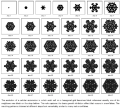| Line 31: | Line 31: | ||
==Emergence of Creative Forms in Cellular Automata== | ==Emergence of Creative Forms in Cellular Automata== | ||
=== patterns: snowflakes, diamonds, and table salt === | === patterns: snowflakes, diamonds, and table salt === | ||
Stephen Wolfram introduced the idea that nature could be explained by simple rules, like cellular automata | |||
<gallery> | <gallery> | ||
image:3-snowflakes-ca.png| CA Snowflakes. Source: A New Kind of Science: Stephen Wolfram | image:3-snowflakes-ca.png| CA Snowflakes. Source: A New Kind of Science: Stephen Wolfram | ||
Revision as of 19:26, 17 November 2015
Life-like Processes in Inorganic Systems
planets
Despite Miller's definition of living systems, their hierarchization might appear interesting at the levels introduced, which include atoms, organizations, and supranational systems. The definition also proposes that there is a non-living system on both sides of the hierarchy. On one side, there are inorganic molecules and, on the other side, inorganic planets and galaxies that demonstrate self-organized processes.
More: Miller, J. G. (1982). “The earth as a system.”
chemical elements and chemical compounds
For example, carbon itself, in the form of a crystal, is considered to be inorganic, but carbon as one element of some compound, wherein part of it is, for example, water, is considered necessary element for forming organic matter (consider alcohol, C2H6O, or methane, CH4). The complexity of defining living systems suggests that, even in the sciences, the border between the living and non-living varies depending on the context, and, therefore, it might be that the concept of life in the context of the human-machine distinction should be approached differently.
crystals: snowflakes, diamonds, and table salt
According to Miller's definition, self-organization emerging from interaction between matter and energy is a natural feature within living systems that lets them survive and continue to propagate. However, if only matter and energy were considered, self-organization would not be an exception in inorganic systems. On the contrary, growing crystals, including snowflakes, diamonds, and table salt, demonstrate life-like and self-organized processes. Life-like processes might be observed in turbulent flows, such as cigarette smoke, streams of moving vehicles, or oceanic currents. Biological evolution also suggests that organic forms evolved from inorganic forms, so, self-organized processes driven by matter and energy, as introduced by Miller, should not be considered a feature of organic nature alone.
Crystals
structure
Crystal atom lattice with periodic order and glass having no periodic order of atoms
more: wikipedia
crystallization and cellular automata
organigenic crystals and pearls
crystals could be also produced by organisms, eg shells produce pearls
Emergence of Creative Forms in Cellular Automata
patterns: snowflakes, diamonds, and table salt
Stephen Wolfram introduced the idea that nature could be explained by simple rules, like cellular automata
cellular automata, fractals and universal computation
game of life and CA demonstrating universal computation
For example, if tested, the rules of Game of Life, while evolving over generations, would look like a real fight for survival
See for example animated video
more: Conway's "Game of Life"
To make things easier and to procure the results of the rules applied to the two-dimensional grid faster than one would on paper, a computer application may be used. In the application Golly46, a number of different rules can be applied and tested over the numerous generations.
more: Software: Golly


